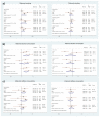Prenatal smoking, alcohol and caffeine exposure and maternal-reported attention deficit hyperactivity disorder symptoms in childhood: triangulation of evidence using negative control and polygenic risk score analyses
- PMID: 34791750
- PMCID: PMC7613851
- DOI: 10.1111/add.15746
Prenatal smoking, alcohol and caffeine exposure and maternal-reported attention deficit hyperactivity disorder symptoms in childhood: triangulation of evidence using negative control and polygenic risk score analyses
Abstract
Background and aims: Studies have indicated that maternal prenatal substance use may be associated with offspring attention deficit hyperactivity disorder (ADHD) via intrauterine effects. We measured associations between prenatal smoking, alcohol and caffeine consumption with childhood ADHD symptoms accounting for shared familial factors.
Design: First, we used a negative control design comparing maternal and paternal substance use. Three models were used for negative control analyses: unadjusted (without confounders), adjusted (including confounders) and mutually adjusted (including confounders and partner's substance use). The results were meta-analysed across the cohorts. Secondly, we used polygenic risk scores (PRS) as proxies for exposures. Maternal PRS for smoking, alcohol and coffee consumption were regressed against ADHD symptoms. We triangulated the results across the two approaches to infer causality.
Setting: We used data from three longitudinal pregnancy cohorts: Avon Longitudinal Study of Parents and Children (ALSPAC) in the United Kingdom, Generation R study (GenR) in the Netherlands and Norwegian Mother, Father and Child Cohort study (MoBa) in Norway.
Participants: Phenotype data available for children were: NALSPAC = 5455-7751; NGENR = 1537-3119; NMOBA = 28 053-42 206. Genotype data available for mothers was: NALSPAC = 7074; NMOBA = 14 583.
Measurements: A measure of offspring ADHD symptoms at age 7-8 years was derived by dichotomizing scores from questionnaires and parental self-reported prenatal substance use was measured at the second pregnancy trimester.
Findings: The pooled estimate for maternal prenatal substance use showed an association with total ADHD symptoms [odds ratio (OR)SMOKING = 1.11, 95% confidence interval (CI) = 1.00-1.23; ORALCOHOL = 1.27, 95% CI = 1.08-1.49; ORCAFFEINE = 1.05, 95% CI = 1.00-1.11], while not for fathers (ORSMOKING = 1.03, 95% CI = 0.95-1.13; ORALCOHOL = 0.83, 95% CI = 0.47-1.48; ORCAFFEINE = 1.02, 95% CI = 0.97-1.07). However, maternal associations did not persist in sensitivity analyses (substance use before pregnancy, adjustment for maternal ADHD symptoms in MoBa). The PRS analyses were inconclusive for an association in ALSPAC or MoBa.
Conclusions: There appears to be no causal intrauterine effect of maternal prenatal substance use on offspring attention deficit hyperactivity disorder symptoms.
Keywords: ALSPAC; Alcohol; GenR; MoBa; caffeine; childhood ADHD; intrauterine effects; negative control; polygenic risk score; smoking.
© 2021 The Authors. Addiction published by John Wiley & Sons Ltd on behalf of Society for the Study of Addiction.
Conflict of interest statement
None
Figures


Similar articles
-
Maternal and offspring genetic risk score analyses of fetal alcohol exposure and attention-deficit hyperactivity disorder risk in offspring.Alcohol Clin Exp Res. 2021 Oct;45(10):2090-2102. doi: 10.1111/acer.14692. Epub 2021 Sep 6. Alcohol Clin Exp Res. 2021. PMID: 34486127 Free PMC article.
-
Associations Between Pregnancy-Related Predisposing Factors for Offspring Neurodevelopmental Conditions and Parental Genetic Liability to Attention-Deficit/Hyperactivity Disorder, Autism, and Schizophrenia: The Norwegian Mother, Father and Child Cohort Study (MoBa).JAMA Psychiatry. 2022 Aug 1;79(8):799-810. doi: 10.1001/jamapsychiatry.2022.1728. JAMA Psychiatry. 2022. PMID: 35793100 Free PMC article.
-
Maternal Fiber Intake During Pregnancy and Development of Attention-Deficit/Hyperactivity Disorder Symptoms Across Childhood: The Norwegian Mother, Father, and Child Cohort Study.Biol Psychiatry. 2024 May 1;95(9):839-848. doi: 10.1016/j.biopsych.2023.12.017. Epub 2023 Dec 22. Biol Psychiatry. 2024. PMID: 38142720
-
Maternal Smoking and Attention-Deficit/Hyperactivity Disorder in Offspring: A Meta-analysis.Pediatrics. 2018 Jan;141(1):e20172465. doi: 10.1542/peds.2017-2465. Pediatrics. 2018. PMID: 29288161 Review.
-
Maternal lifestyle factors in pregnancy risk of attention deficit hyperactivity disorder and associated behaviors: review of the current evidence.Am J Psychiatry. 2003 Jun;160(6):1028-40. doi: 10.1176/appi.ajp.160.6.1028. Am J Psychiatry. 2003. PMID: 12777257 Review.
Cited by
-
Mediating Factors in the Association of Maternal Educational Level With Pregnancy Outcomes: A Mendelian Randomization Study.JAMA Netw Open. 2024 Jan 2;7(1):e2351166. doi: 10.1001/jamanetworkopen.2023.51166. JAMA Netw Open. 2024. PMID: 38206626 Free PMC article.
-
A systematic meta-review of systematic reviews on attention deficit hyperactivity disorder.Eur Psychiatry. 2023 Nov 17;66(1):e90. doi: 10.1192/j.eurpsy.2023.2451. Eur Psychiatry. 2023. PMID: 37974470 Free PMC article. Review.
-
In Utero Exposure to Alcohol and Tobacco and Electroencephalogram Power During Childhood.JAMA Netw Open. 2024 Jan 2;7(1):e2350528. doi: 10.1001/jamanetworkopen.2023.50528. JAMA Netw Open. 2024. PMID: 38180758 Free PMC article.
-
The association between maternal tobacco smoking during pregnancy and the risk of attention-deficit/hyperactivity disorder (ADHD) in offspring: A systematic review and meta-analysis.PLoS One. 2025 Feb 7;20(2):e0317112. doi: 10.1371/journal.pone.0317112. eCollection 2025. PLoS One. 2025. PMID: 39919144 Free PMC article.
-
Mendelian randomization analysis of maternal coffee consumption during pregnancy on offspring neurodevelopmental difficulties in the Norwegian Mother, Father and Child Cohort Study (MoBa).Psychol Med. 2024 Oct 9;54(12):1-14. doi: 10.1017/S0033291724002216. Online ahead of print. Psychol Med. 2024. PMID: 39382486 Free PMC article.
References
-
- Huang L, Wang Y, Zhang L, Zheng Z, Zhu T, Qu Y, Mu D, et al. Maternal Smoking and Attention-Deficit/Hyperactivity Disorder in Offspring: A Meta-analysis. Pediatrics. 2017;14(1):11. - PubMed
-
- He Y, Chen J, Zhu LH, Hua LL, Ke FF. Maternal Smoking During Pregnancy and ADHD: Results From a Systematic Review and Meta-Analysis of Prospective Cohort Studies. J Atten Disord. 2020;24(12):1637–47. - PubMed
-
- Porter MS, Maravilla JC, Betts KS, Alati R. Low-moderate prenatal alcohol exposure and offspring attention-deficit hyperactivity disorder (ADHD): systematic review and meta-analysis. Arch Gynecol Obstet. 2019;300(2):269–77. - PubMed
-
- Pagnin D, Grecco MLZ, Furtado EF. Prenatal alcohol use as a risk for attention-deficit/hyperactivity disorder. Eur Arch Psy Clin N. 2019;269(6):681–7. - PubMed
-
- Mikkelsen SH, Obel C, Olsen J, Niclasen J, Bech BH. Maternal Caffeine Consumption during Pregnancy and Behavioral Disorders in ll-Year-Old Offspring: A Danish National Birth Cohort Study. J Pediatr-Us. 2017;189:120. - PubMed
Publication types
MeSH terms
Substances
Grants and funding
LinkOut - more resources
Full Text Sources
Medical

